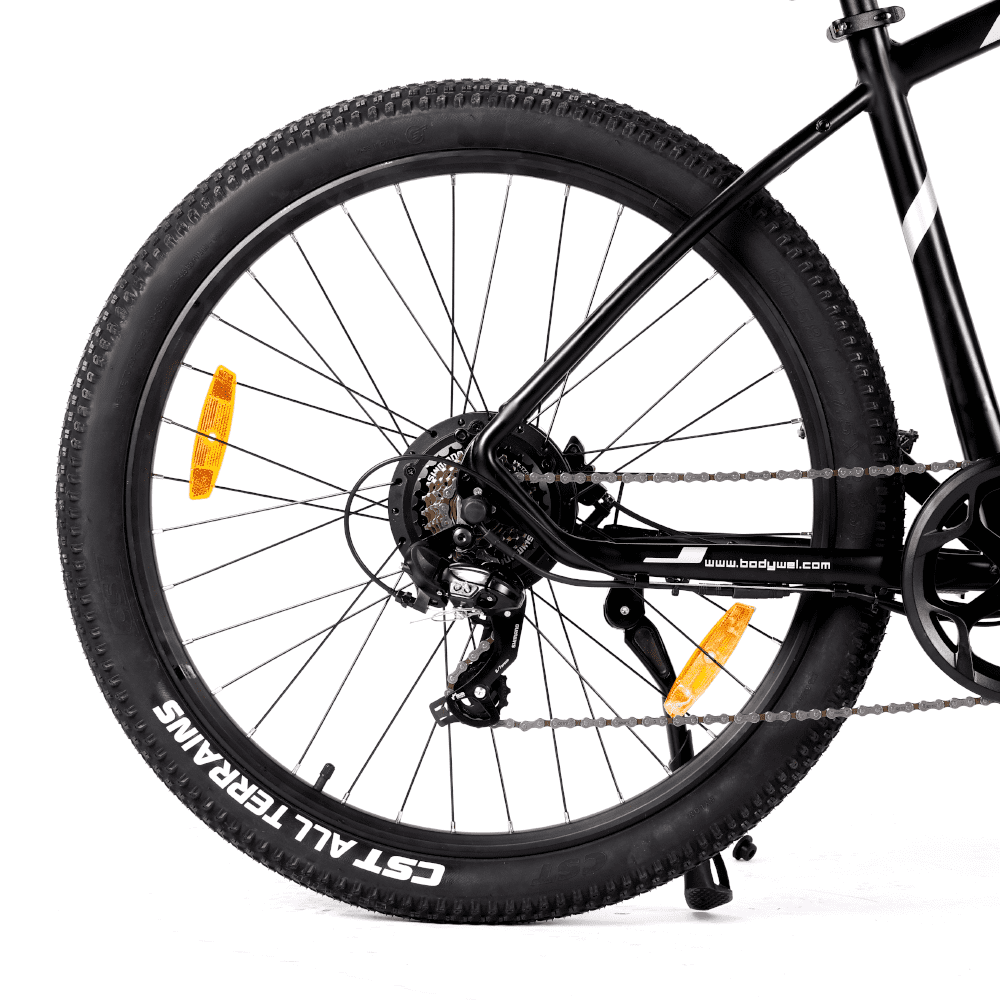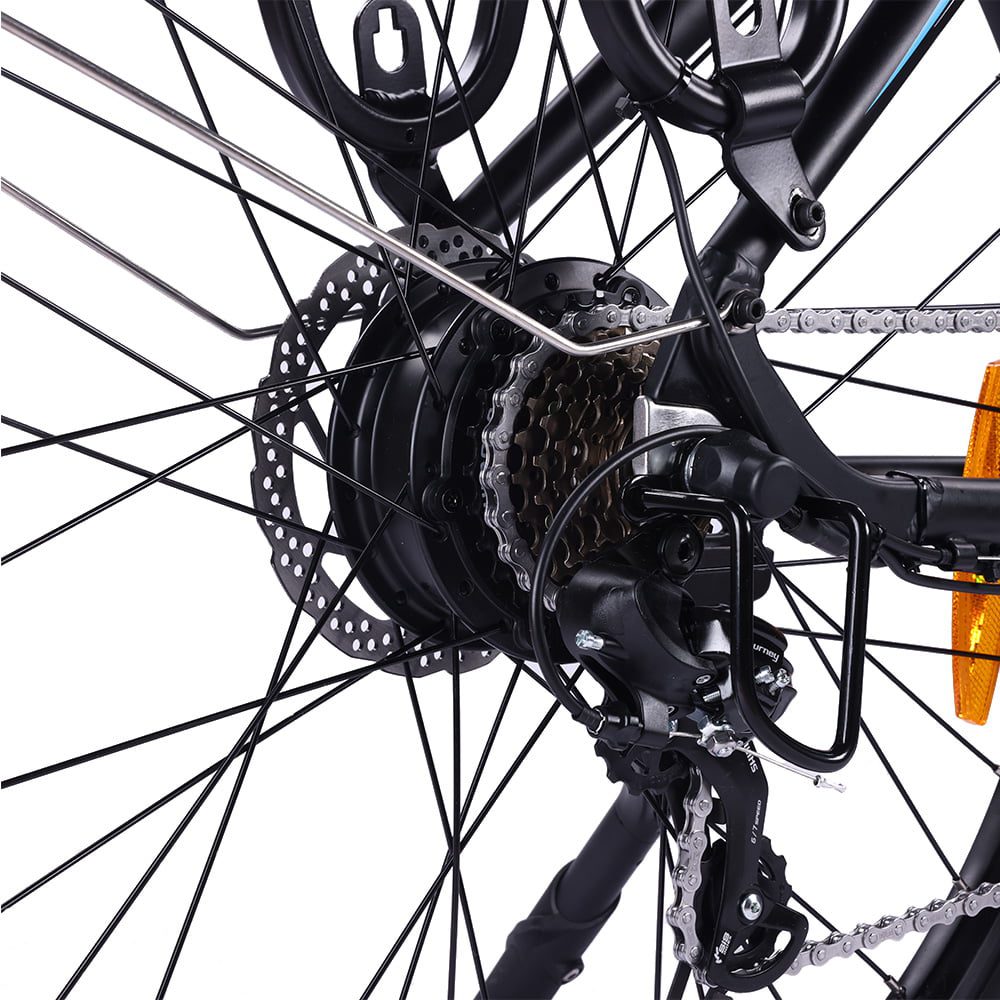When you first start cycling you step into a world filled with complex parts and interesting mechanics. It’s important to grasp the main elements that make a ride enjoyable. This beginner’s manual is designed for those seeking to get acquainted with bike parts focusing on the freewheel – a component vital in biking lingo.
What does a freewheel do on a bicycle? It allows cyclists to glide without having to pedal. This explanation aims to simplify the concept of the freewheel giving you insight, deep into your bike’s functioning and how to maintain it properly.
Understanding the Role of a Freewheel in Cycling
The freewheel feature is essential, for bicycles to enhance comfort and efficiency while riding in particular. It allows the back wheel to rotate freely without pedaling, conserving energy and facilitating effortless coasting.
Bike freewheels include a function that helps cyclists measure their exertion. These components affect the bikes movement, which’s crucial for riders of all kinds. Freewheels also assist in pedaling, key for biking endeavors from competitive racing, to everyday city cycling.
| Feature | Importance in Cycling |
| Allow Wheel Roll | Enables the wheel to spin freely, aiding in maintaining momentum without continuous pedaling. |
| Energy Conservation | Reduces fatigue by allowing cyclists to rest while moving, especially beneficial on downhill terrains. |
| Control Over Speed | Helps in managing speed more efficiently without the need for constant braking. |
| Smooth Transition | Facilitates a smoother transition between gears, improving the cycling experience. |
| Performance Optimization | Contributes to optimal performance by enabling better control and efficiency during rides. |
The freewheel function is crucial for both serious cyclists and amateurs. It improves the quality and smoothness of cycling experiences highlighting the importance of comprehension and upkeep.
What Is a Freewheel on a Bicycle?
The freewheel is important, due to its gear mechanism enabling the wheel to spin while the pedals stay still or go backward. This showcases how crucial the freewheel is, in improving cycling and racing adventures.
The Basic Concept of Freewheel Mechanism
Riders can glide using the freewheel and moving ahead without the need to pedal. This mechanism employs a ratchet and pawl system connected to the back wheel. When pedaling, the pawls engage with the ratchet transferring energy to the wheel.
When you cease pedaling the pawls disengage, allowing the wheel to spin freely. This enables effortless gliding.
The Importance of Freewheel for Smooth Riding
A freewheel is essential, for a smooth cycling experience as it enhances efficiency and comfort. It allows cyclists to coast without pedaling, ideal for rides or quick pauses. This feature not adds enjoyment to biking. It also increases safety.
| Feature | Benefit |
| Engagement of the ratchet-and-pawl | Allows transmission of power effectively from pedals to wheel |
| Disengagement while coasting | Provides smoother and effortless riding during descents or resting phases |

How Does a Bicycle Freewheel Work?
Understanding freewheels requires recognizing the significance of the gear mechanism while cycling. The freewheel element in a bicycles gear system allows riders to glide smoothly conserving energy as they travel.
The heart of a freewheel’s operation is its ratchet-and-pawl system. When pedaling, the pawls lock into the ratchet, sending power to the wheel. But when you stop pedaling, the pawls let go. This lets the rear wheel spin freely, allowing coasting.
To gain an understanding of freewheels lets delve into the interplay between the ratchet, pawls and bike gear:
- Ratchet: A circular disk with teeth on its inner side, inside the rear hub.
- Pawls: Spring-loaded levers that catch the ratchet’s teeth when pedaling and slide off when you stop.
- Hub Shell: Holds the freewheel parts and connects to the rear wheel with spokes.
The collaboration, among components highlights the ingenuity of bicycle gear mechanisms ensuring that cyclists can pedal and coast, with ease.
Switching effortlessly between pedaling and coasting enhances a cyclist’s endurance and enjoyment. It demonstrates the clever engineering behind bicycle equipment.
The Anatomy of Bicycle Drivetrain Components
Exploring the world of cycling, the bicycle drivetrain is key for a bike’s smooth operation. It lets riders change gears easily, adapting to different terrains and speeds. Let’s dive into the main parts, focusing on the gear system.
An Overview of Bicycle Components Freewheel
The freewheel is an important component in a bike’s drivetrain as it enables coasting without requiring pedal motion when the wheels are turning. Its smooth integration with parts improves the riding experience making it more seamless and effective. This highlights how every part forming the drivetrain system is interconnected.
Bike Gear Mechanism: Understanding Freewheels
The freewheel mechanism, belonging to bicycles, is linked to the gear system. It engages with the chain while pedaling and disengages when there is no pedaling or when moving in reverse. This function improves convenience and safety by halting pedal rotation.
This look into freewheels deepens our understanding of how each bike part works together for a smooth ride.
- Bicycle Drivetrain: Includes gears, cranksets, chain, freewheel, and derailleurs that make the bike move.
- Bicycle Drivetrain Components: Parts like the chain, chainrings, cassette, and derailleurs each play a key role in shifting gears and adjusting speed.
- Bicycle Gear System: This system lets riders change gears for different terrains and speeds, mainly using the freewheel and gear shifters.
- Bike Gear Components: Items like the freewheel, cogs, and shifters help the bike work well in various conditions.
Cyclists can gain an insight into their bikes by examining these components. The functionality of each part significantly impacts the riding experience underscoring the importance of being knowledgeable, especially about and properly maintaining the drivetrain and gear systems.

Bicycle Freewheel vs Cassette: What’s the Difference?
To comprehend the fundamentals of bicycle drivetrain it’s essential to distinguish between freewheel and cassette components. These elements play a key role in the functionality of bicycles each serving distinct purposes to cater to various cycling requirements.
The contrast between freewheel and cassette lies primarily in their structure and functionality with the bicycle. A freewheel functions as an entity featuring gears and a mechanism that allows easy turning in one direction. While a cassette comprises a series of cogs that can be attached to a hub, equipped with an integrated mechanism.
- A freewheel connects directly to the rear hub, allowing it to spin freely in one direction and lock in the other to power the rear wheel.
- A cassette fits over a freehub, secured by splines on the hub. This setup makes it easy to change gear ratios and use bigger sprockets.
| Component | Structure | Compatibility | Maintenance |
| Freewheel | Integrated cog and ratchet | Older bike models | Higher, complete replacement needed |
| Cassette | Separate cogs, independent ratchet in hub | Newer bike models, high-speed systems | Lower, individual cogs replaceable |
Understanding the understanding of bicycle drivetrain shows how these parts affect bike performance and upkeep. Choosing between a freewheel and a cassette impacts shifting ease, bike weight, and part upgrade or replacement simplicity.
Types of Freewheels for Bicycles and Their Applications
When you delve into the varieties of freewheels designed for bicycles you can see their impact on the bike’s gear system. Each type caters to different riding conditions and requirements. Selecting the suitable one is crucial, for enhancing performance.
Freewheel Mechanism Explained
A freewheel on the wheel of a bike enables the cyclist to glide without needing to pedal. It’s useful for saving energy on rides or when descending slopes. Various freewheel options are ready, to suit riding styles from leisurely city biking to thrilling mountain trails.
Selecting the Right Bicycle Gear System
Selecting the right bicycle components, such as the freewheel entails understanding your requirements and the type of terrain you plan to traverse. A suited freewheel enhances riding comfort. Moreover it provides improved maneuverability across various landscapes.
| Type | Best Use | Characteristic |
| Standard Threaded Freewheels | Road and casual cycling | Easy to replace and maintain; offers basic gearing options |
| BMX Freewheels | BMX and stunt riding | Durable; designed for short, high power bursts |
| Mountain Bike Freewheels | Off-road and rugged terrains | Robust; provides a wide range of gears to handle steep climbs |
| Multi-Speed Freewheels | Versatile usage | Offers multiple gear ratios for various terrains and speeds |
Introduction to Bodywel E-Bike Freewheel and Installation
E bikes are gaining popularity due to their nature and effectiveness. Selecting top notch components plays a role in ensuring performance. The Bodywel E-Bike Freewheel stands out as a favored option among e bike enthusiasts, boasting special characteristics and advantages. In this segment we will delve into the details of the Bodywel E–Bike Freewheel. And we provide guidance on how to install it for a riding experience.
Key Features of the Bodywel E-Bike Freewheel
The Bodywel E Bike Freewheel is specifically designed for electric bicycles, boasting durability and a robust build. It enhances gear shifting efficiency. It also seamlessly integrates with e bike motors. With a corrosion coating and precision engineering it ensures high performance in every ride.
Freewheel Installation Guide: A Step-by-Step Outline
- Preparation: Get your tools ready like a freewheel remover tool, wrenches, and lubricant. Make sure your e-bike is on a stand.
- Removal of Old Freewheel: Use the freewheel remover tool in the freewheel’s center. Attach a wrench and turn it counterclockwise to remove the old freewheel.
- Clean and Inspect: Clean the hub threads with a brush and check for damage. Put grease on the threads for smooth installation.
- Installing the Bodywel E-Bike Freewheel: Hand-thread the Bodywel Freewheel onto the hub. Then, use the tool and wrench to tighten it clockwise.
- Final Checks: Spin the wheel to check for any issues. Make sure it’s tight and adjust if needed.
- Test Ride: Take a short ride to make sure everything works well. Check that the freewheel responds as it should with the e-bike.
Installing the freewheel correctly is crucial for enhancing your e bike’s performance. Adhering to these guidelines can ensure that riders experience a safer journey. The Bodywel E Bike Freewheel enhances bike performance offering riders improved efficiency and reliability for an riding experience.
-A001-主图10.png)
Freewheel Maintenance Tips for Enhanced Bike Performance
Ensuring that your bicycles freewheel is well maintained is essential for a ride. Routine care of the freewheel prevents damage helping you avoid expensive repairs. Below are some tips on maintaining your bikes freewheel that every cyclist ought to be aware of.
- Clean Regularly: Dirt and grime can build up in the freewheel, making it work poorly. Clean the freewheel well after rides, especially in muddy or wet conditions.
- Lubricate the Freewheel: After cleaning, make sure the freewheel is well-lubricated. This reduces friction and stops rust. Use a high-quality lubricant made for your biking needs.
- Check for Wear and Tear: Check your freewheel often for wear or damage. Look for rust, broken teeth, or strange noises while cycling. Spotting these early can save you from big problems later.
- Professional Inspections: Regular bike freewheel maintenance is good, but get a pro to check it every year. They can do a thorough check and catch issues you might miss.
- Replacement Timing: Freewheels don’t last forever. Know how long yours should last and be ready to replace it when needed. This keeps your bike running well.
By following these tips for maintaining, your freewheel you can extend its lifespan, and improve your cycling experience. Consistent and thorough maintenance do not enhance your bikes performance only. It also ensures your safety while riding.
Conclusion
In this guide we’ve delved into the realm of freewheel technology. It plays a vital role, in enhancing the performance and efficiency of bicycles. By gaining insights into freewheel technology cyclists can enhance their biking experience and address bike related problems with ease. This knowledge benefits both novice and seasoned riders in elevating their cycling endeavors.
Understanding freewheel systems is essential, whether you’re interested in bike maintenance or simply looking for a cycling experience. With advancements in cycling technology products such as E Bike Freewheel of Bodywel are becoming increasingly significant. This guide aims to assist you in making decisions for your bike and appreciating the engineering laying behind bicycle freewheels.
FAQ
Why is a freewheel important in cycling?
The freewheel makes riding smoother by letting you rest your legs while moving. You can coast without having to pedal.
How does a freewheel work on a bike?
A freewheel has a special mechanism that locks when you pedal, connecting the chain to power the bike. When you stop pedaling, it unlocks, letting the wheel spin freely.
What’s the difference between a freewheel and a cassette?
A freewheel is a single gear cluster with a built-in mechanism, while a cassette is a set of gears that slide onto the bike’s hub. The hub’s mechanism engages and disengages the gears.
How can I maintain my bike’s freewheel?
Keep your bike’s freewheel in top shape by cleaning it, lubricating it, and checking for wear. Getting a professional check-up and adjustment now and then is also a good idea.
Can the freewheel affect bike performance?
Definitely. A well-kept freewheel ensures that power from the pedals moves smoothly to the wheel. This boosts the bike’s performance.
How do I install a freewheel on my bicycle?
To install a freewheel, line up the threads on the freewheel with those on the rear hub. Then, screw it on by hand and tighten it with a special tool.
How often should I perform maintenance on a bike freewheel?
How often you should check and clean your freewheel depends on how you ride and the conditions you ride in. But, it’s a good idea to inspect and clean it every few months or after tough rides.


